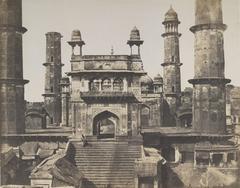Visiting the Ghats in Mathura: History, Tips, and Visitor Information
Publication Date: 18/07/2024
Introduction to the Ghats in Mathura
Table of Contents
- Introduction
- Ancient Origins and Evolution
- Architectural Heritage and Evolution
- Religious Significance and Ritual Practices
- Social and Cultural Hubs
- Notable Ghats of Mathura
- Practical Visitor Information
- Special Events and Guided Tours
- Photographic Spots
- Conclusion
- FAQ
Ancient Origins and Evolution
Mathura has been a significant pilgrimage destination for millennia. The ghats, serving as vital access points to the Yamuna, have witnessed the ebb and flow of empires and religious fervor over centuries.
While pinpointing the exact origins of the ghats remains a challenge due to limited historical records, their existence is intertwined with the city’s ancient past. References to sacred bathing spots along the Yamuna in ancient Hindu scriptures like the Bhagavata Purana suggest the presence of ghats since time immemorial.
The ghats we see today, however, are largely attributed to the patronage of various rulers and wealthy merchants, particularly during the Mughal and post-Mughal periods. These patrons recognized the religious and social importance of the ghats, investing in their construction and expansion.
Architectural Heritage and Evolution
The architectural styles of Mathura’s ghats reflect the artistic sensibilities of the eras they were built in. Many ghats showcase a blend of Mughal and Hindu architectural elements, a testament to the city’s syncretic cultural heritage.
Intricate carvings, ornate pavilions, and majestic archways adorn several ghats, showcasing the craftsmanship of bygone eras. Vishram Ghat, for instance, boasts a beautiful palace built by the Scindias of Gwalior in the 19th century.
Over time, the ghats have undergone renovations and expansions to accommodate the increasing number of pilgrims. However, the essence of their ancient architecture and spiritual aura continues to captivate visitors.
Religious Significance and Ritual Practices
The ghats of Mathura hold profound religious significance for Hindus, particularly for devotees of Lord Krishna. The Yamuna River, considered sacred in Hinduism, is believed to absolve sins and bestow blessings upon those who bathe in its waters.
The ghats serve as sacred thresholds between the earthly realm and the divine, where devotees can connect with their faith and seek spiritual solace. Each ghat holds specific legends and beliefs associated with Lord Krishna’s life and teachings.
Key Rituals Performed at the Ghats
- Ritual Bathing: Devotees believe that taking a dip in the Yamuna, especially during auspicious occasions, purifies the soul and washes away sins.
- Pinda Daan: This ritual, performed for the deceased, involves offering rice balls to appease their souls and facilitate their journey to the afterlife.
- Evening Aarti: As the sun sets, the ghats come alive with the sights and sounds of the evening aarti, a devotional ceremony of light and incense offered to the river deity.
- Chanting and Meditation: The serene atmosphere of the ghats provides an ideal setting for spiritual practices like chanting mantras and meditation.
Social and Cultural Hubs
Beyond their religious significance, the ghats of Mathura also serve as vibrant social and cultural hubs. They are spaces where people from all walks of life converge, fostering a sense of community and shared faith.
Local festivals and celebrations often center around the ghats, adding to their vibrancy and cultural richness. The ghats also provide a glimpse into the daily lives of the local people, their customs, and traditions.
Notable Ghats of Mathura
Mathura boasts over 25 ghats, each with its own unique history and significance. Some of the most notable ones include:
- Vishram Ghat: Considered the most sacred ghat in Mathura, it is believed to be the place where Lord Krishna rested after slaying the demon king Kansa.
- Dwarkadhish Ghat: Located near the iconic Dwarkadhish Temple, this ghat is known for its elaborate evening aarti ceremony.
- Kans Qila Ghat: Situated near the ruins of Kans Fort, this ghat offers panoramic views of other ghats and the city.
- Prayag Ghat: Believed to be as sacred as the Prayag in Allahabad, this ghat is a popular spot for pinda daan rituals.
- Govardhan Ghat: Named after the sacred Govardhan Hill, this ghat is known for its peaceful ambiance and is ideal for meditation.
Practical Visitor Information
Visiting Hours
The ghats are generally open 24/7, but the best times to visit are early morning and evening, especially during aarti ceremonies.
Tickets
There is no entry fee to visit the ghats. However, some specific rituals and ceremonies may require nominal charges.
Travel Tips
- Dress modestly and respectfully.
- Be mindful of your belongings.
- Engage with local guides for a more enriching experience.
Nearby Attractions
Besides the ghats, visitors can explore the Dwarkadhish Temple, Krishna Janmasthan Temple, and the Mathura Museum.
Accessibility
Most ghats have steps leading down to the river, which may not be suitable for those with mobility issues. However, some ghats offer ramps and other facilities for better accessibility.
Special Events and Guided Tours
Mathura’s ghats host several special events throughout the year, including Janmashtami celebrations, Holi, and Diwali. Guided tours are available and highly recommended for those looking to delve deeper into the history and significance of these sites.
Photographic Spots
The ghats provide numerous picturesque spots for photography, particularly during sunrise and sunset. Vishram Ghat and Dwarkadhish Ghat are especially popular among photographers.
Conclusion
FAQ
Q: What are the best times to visit Mathura ghats?
A: Early morning and evening, especially during aarti ceremonies.
Q: Are there guided tours available?
A: Yes, guided tours are available and recommended for a more enriching experience.
Q: Is there an entry fee to visit the ghats?
A: No, there is no entry fee to visit the ghats, though some rituals may have nominal charges.
Q: How can I ensure a respectful visit to the ghats?
A: Dress modestly, be mindful of your belongings, and engage with local guides for better insight.
Q: What nearby attractions can I visit along with the ghats?
A: Dwarkadhish Temple, Krishna Janmasthan Temple, and the Mathura Museum are nearby attractions worth visiting.

